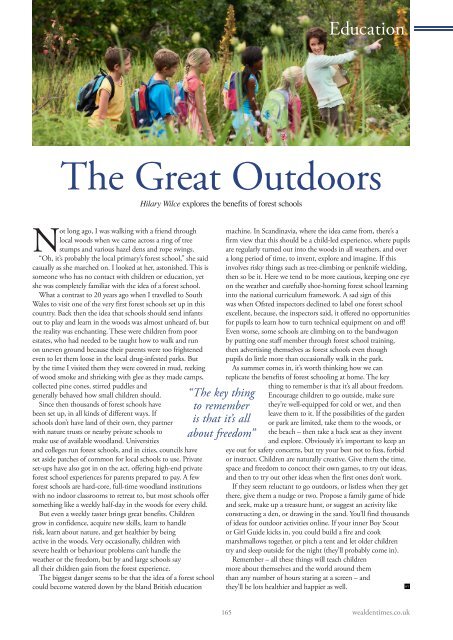Wealden Times | WT208 | June 2019 | Kitchen & Bathroom supplement inside
Wealden Times - The lifestyle magazine for the Weald
Wealden Times - The lifestyle magazine for the Weald
You also want an ePaper? Increase the reach of your titles
YUMPU automatically turns print PDFs into web optimized ePapers that Google loves.
Education<br />
The Great Outdoors<br />
Hilary Wilce explores the benefits of forest schools<br />
Not long ago, I was walking with a friend through<br />
local woods when we came across a ring of tree<br />
stumps and various hazel dens and rope swings.<br />
“Oh, it’s probably the local primary’s forest school,” she said<br />
casually as she marched on. I looked at her, astonished. This is<br />
someone who has no contact with children or education, yet<br />
she was completely familiar with the idea of a forest school.<br />
What a contrast to 20 years ago when I travelled to South<br />
Wales to visit one of the very first forest schools set up in this<br />
country. Back then the idea that schools should send infants<br />
out to play and learn in the woods was almost unheard of, but<br />
the reality was enchanting. These were children from poor<br />
estates, who had needed to be taught how to walk and run<br />
on uneven ground because their parents were too frightened<br />
even to let them loose in the local drug-infested parks. But<br />
by the time I visited them they were covered in mud, reeking<br />
of wood smoke and shrieking with glee as they made camps,<br />
collected pine cones, stirred puddles and<br />
generally behaved how small children should.<br />
Since then thousands of forest schools have<br />
been set up, in all kinds of different ways. If<br />
schools don’t have land of their own, they partner<br />
with nature trusts or nearby private schools to<br />
make use of available woodland. Universities<br />
and colleges run forest schools, and in cities, councils have<br />
set aside patches of common for local schools to use. Private<br />
set-ups have also got in on the act, offering high-end private<br />
forest school experiences for parents prepared to pay. A few<br />
forest schools are hard-core, full-time woodland institutions<br />
with no indoor classrooms to retreat to, but most schools offer<br />
something like a weekly half-day in the woods for every child.<br />
But even a weekly taster brings great benefits. Children<br />
grow in confidence, acquire new skills, learn to handle<br />
risk, learn about nature, and get healthier by being<br />
active in the woods. Very occasionally, children with<br />
severe health or behaviour problems can’t handle the<br />
weather or the freedom, but by and large schools say<br />
all their children gain from the forest experience.<br />
The biggest danger seems to be that the idea of a forest school<br />
could become watered down by the bland British education<br />
“The key thing<br />
to remember<br />
is that it’s all<br />
about freedom”<br />
machine. In Scandinavia, where the idea came from, there’s a<br />
firm view that this should be a child-led experience, where pupils<br />
are regularly turned out into the woods in all weathers, and over<br />
a long period of time, to invent, explore and imagine. If this<br />
involves risky things such as tree-climbing or penknife wielding,<br />
then so be it. Here we tend to be more cautious, keeping one eye<br />
on the weather and carefully shoe-horning forest school learning<br />
into the national curriculum framework. A sad sign of this<br />
was when Ofsted inspectors declined to label one forest school<br />
excellent, because, the inspectors said, it offered no opportunities<br />
for pupils to learn how to turn technical equipment on and off!<br />
Even worse, some schools are climbing on to the bandwagon<br />
by putting one staff member through forest school training,<br />
then advertising themselves as forest schools even though<br />
pupils do little more than occasionally walk in the park.<br />
As summer comes in, it’s worth thinking how we can<br />
replicate the benefits of forest schooling at home. The key<br />
thing to remember is that it’s all about freedom.<br />
Encourage children to go outside, make sure<br />
they’re well-equipped for cold or wet, and then<br />
leave them to it. If the possibilities of the garden<br />
or park are limited, take them to the woods, or<br />
the beach – then take a back seat as they invent<br />
and explore. Obviously it’s important to keep an<br />
eye out for safety concerns, but try your best not to fuss, forbid<br />
or instruct. Children are naturally creative. Give them the time,<br />
space and freedom to concoct their own games, to try out ideas,<br />
and then to try out other ideas when the first ones don’t work.<br />
If they seem reluctant to go outdoors, or listless when they get<br />
there, give them a nudge or two. Propose a family game of hide<br />
and seek, make up a treasure hunt, or suggest an activity like<br />
constructing a den, or drawing in the sand. You’ll find thousands<br />
of ideas for outdoor activities online. If your inner Boy Scout<br />
or Girl Guide kicks in, you could build a fire and cook<br />
marshmallows together, or pitch a tent and let older children<br />
try and sleep outside for the night (they’ll probably come in).<br />
Remember – all these things will teach children<br />
more about themselves and the world around them<br />
than any number of hours staring at a screen – and<br />
they’ll be lots healthier and happier as well.<br />
165 wealdentimes.co.uk


















